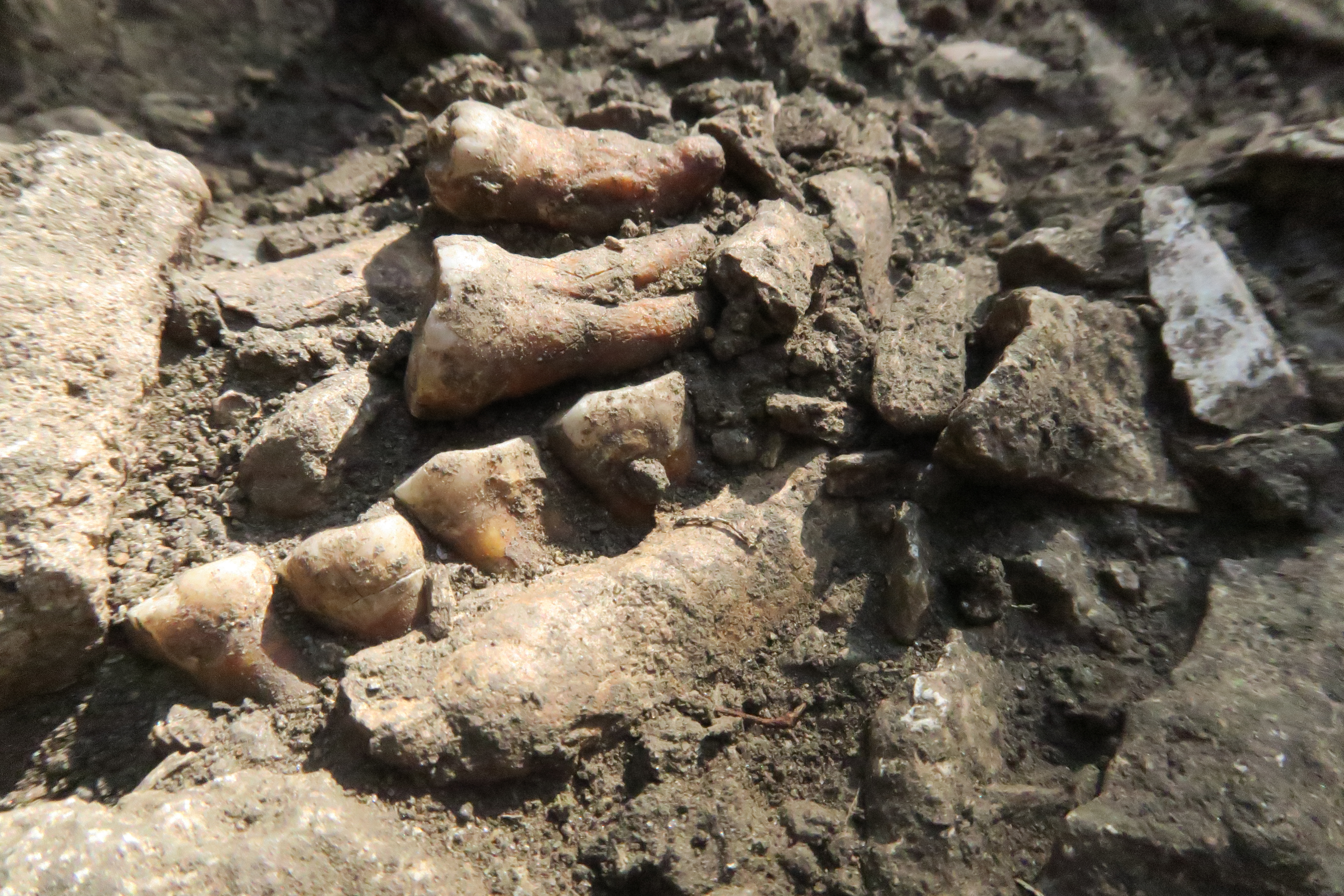Genetics
Two Lions Went on a Man-Eating Spree in 1898. Now, DNA Evidence Reveals Their Diets
The notorious predators, nicknamed the “Man-Eaters of Tsavo,” terrorized railway workers in Kenya for roughly nine months
From Silk Moths to Fruit Flies, These Five Insects Have Changed the World
It’s easy to write bugs off as pests, but consider the ways in which they have positively impacted our lives
American Scientists Win Nobel Prize in Medicine for 'Groundbreaking' Gene Discovery Made by Studying Worms
Victor Ambros and Gary Ruvkun discovered microRNA, tiny molecules that play a crucial role in how cells develop, paving the way for new treatments for diseases
Scientists Unveil the First-Ever Complete Map of an Adult Fruit Fly's Brain, Captured in Stunning Detail
The brain diagram, called a connectome, could revolutionize researchers' understanding of the human brain, which has many parallels with a fruit fly's
Montana Rancher Who Created Giant, Hybrid Sheep Sentenced to Six Months in Prison
Arthur “Jack” Schubarth cloned illegally imported genetic material from the Marco Polo argali to create hybrid sheep that would draw higher prices from hunting preserves
Breast Cancer Cases Are Rising Among Younger Women, Report Finds
Though breast cancer mortality is declining overall, Asian American women and women under 50 have experienced an uptick in diagnoses of the disease
In Case Humans Go Extinct, This Memory Crystal Will Store Our Genome for Billions of Years
Scientists have created "a form of information immortality" meant to instruct future species on how to recreate humans. But who, or what, will find it?
Easter Island's Ancient Population Never Faced Ecological Collapse, Suggests Another Study
New DNA analysis adds to growing research indicating the famous Pacific island did not collapse from overuse of resources before the arrival of Europeans
Ancient DNA Reveals Neanderthal Group Was Isolated for 50,000 Years
A new study, based on the remains of a Neanderthal nicknamed Thorin, is shaking up what archaeologists long thought about these early humans in Europe
Scientists Identify the Gene Behind Thorny Roses and Other Prickly Plants
A recent study could pave the way to cultivating various thornless plants, making them easier to grow and potentially more widely available
Inside the Hidden Kingdom of Viruses in Your Gut
Human innards are teeming with viruses that infect bacteria. Here's what scientists are learning about them
Can the Endangered Rusty Patched Bumblebee Survive?
A new genetic study reveals secrets about the creature, which may help researchers make decisions to conserve the species
Archaeologists May Have Identified the Bones of a Celebrated Ninth-Century Bishop in Spain
Bishop Teodomiro was a central figure in the creation of the Camino de Santiago pilgrimage
The World's Largest Animal Genome Belongs to an Odd, Air-Breathing Fish
Scientists sequenced the 91 billion base pairs in the South American lungfish’s genome, setting a record and revealing insights into vertebrate evolution
Early Humans Migrated Out of Africa Several Times, DNA Study Suggests
Homo sapiens interbred with Neanderthals as early as 250,000 years ago and may have ultimately bred them out of existence, according to new research
Archaeologists Crack Open a 2,000-Year-Old Coffin in Italy's ‘Tomb of Cerberus’
The stone coffin likely contains the leader of the family that built the frescoed chamber in Naples
3D DNA Preserved for 52,000 Years in Freeze-Dried Woolly Mammoth Remains
For the first time, researchers have mapped ancient genetic material in unprecedented detail
Ancient DNA Unravels the Mysteries of the Dingo, Australia's Wild Dog
Researchers dove into thousands of years of evolutionary history, revealing new insights about the iconic, though sometimes vilified, canines
What Killed the Last Woolly Mammoths? Scientists Say It Wasn't Inbreeding
New research suggests some catastrophic event—such as a natural disaster or a virus—killed the world's last known population of mammoths on Wrangel Island
These Stunning Butterflies Flew 2,600 Miles Across the Atlantic Ocean Without Stopping
Researchers combined several lines of evidence to solve the mystery of why a group of painted ladies, which do not live in South America, were found fluttering on a beach in French Guiana
Page 1 of 31
:focal(351x234:352x235)/https://tf-cmsv2-smithsonianmag-media.s3.amazonaws.com/filer_public/fc/91/fc912dea-5c42-4fd3-90b5-1b9d2081134f/lionsoftsavo2008.jpg)
:focal(1009x745:1010x746)/https://tf-cmsv2-smithsonianmag-media.s3.amazonaws.com/filer_public/8e/88/8e88895c-c55b-4a1c-8419-95a9ec25b4bf/gettyimages-987257254.jpg)
:focal(3402x2268:3403x2269)/https://tf-cmsv2-smithsonianmag-media.s3.amazonaws.com/filer_public/27/85/278532d8-0090-42d6-9ff6-77449b49da84/gettyimages-2176426457.jpg)
:focal(1440x960:1441x961)/https://tf-cmsv2-smithsonianmag-media.s3.amazonaws.com/filer_public/b1/25/b12582c3-4fdf-4447-9938-41a2fb15bb60/fw_all_l.png)
:focal(1024x683:1025x684)/https://tf-cmsv2-smithsonianmag-media.s3.amazonaws.com/filer_public/d1/51/d151d4a5-2747-41a7-8079-14ef0a402d1c/6036855262_5e539058f1_k.jpg)
:focal(1060x717:1061x718)/https://tf-cmsv2-smithsonianmag-media.s3.amazonaws.com/filer_public/58/6b/586bf226-844c-41e0-a28f-be9217d380f6/gettyimages-2147721996.jpg)
:focal(1024x575:1025x576)/https://tf-cmsv2-smithsonianmag-media.s3.amazonaws.com/filer_public/5a/e2/5ae236c1-dbe7-48a0-9b08-03e71a9e2590/skynews-genome-5d-crystal_6689808.jpg)
:focal(1200x800:1201x801)/https://tf-cmsv2-smithsonianmag-media.s3.amazonaws.com/filer_public/58/d8/58d86da0-cbee-4298-9a13-039bea8d2ae3/thomas-griggs-anvaqssbtms-unsplash.jpg)

:focal(2128x1419:2129x1420)/https://tf-cmsv2-smithsonianmag-media.s3.amazonaws.com/filer_public/25/28/2528f427-5b55-4e98-b85e-5f9523b4fc9a/gettyimages-157567545.jpg)
:focal(800x602:801x603)/https://tf-cmsv2-smithsonianmag-media.s3.amazonaws.com/filer_public/46/02/46026cf0-fbc2-4552-aa5c-fb19a8430429/gettyimages-1333712258_web.jpg)
:focal(800x602:801x603)/https://tf-cmsv2-smithsonianmag-media.s3.amazonaws.com/filer_public/0c/81/0c81aeeb-205c-49dc-b079-e5813a9b3670/rusty-patched-bumble-bee-09956_web.jpg)
:focal(587x441:588x442)/https://tf-cmsv2-smithsonianmag-media.s3.amazonaws.com/filer_public/0c/f8/0cf813ef-9e3c-41ef-ba89-dec6d504837e/urn_cambridgeorg_id_binary-alt_20240805235708-82096-optimisedimage-png-s0003598x24000917_fig6.jpeg)
:focal(2000x1505:2001x1506)/https://tf-cmsv2-smithsonianmag-media.s3.amazonaws.com/filer_public/b8/63/b863fe13-8270-4ba6-8d7a-baff88e850ff/south_american_lungfish_lepidosiren_paradoxa_1.jpg)
:focal(1750x1175:1751x1176)/https://tf-cmsv2-smithsonianmag-media.s3.amazonaws.com/filer_public/97/36/973642de-8855-4633-93eb-3facdabad0ea/gettyimages-853018002.jpg)
:focal(711x535:712x536)/https://tf-cmsv2-smithsonianmag-media.s3.amazonaws.com/filer_public/93/19/93195afd-c06e-4600-8f52-641abbe89d17/whatsapp-image-2023-10-06-at-183225-jpeg.jpeg)
:focal(600x400:601x401)/https://tf-cmsv2-smithsonianmag-media.s3.amazonaws.com/filer_public/9d/03/9d03e8f0-5b0e-4445-b90a-69b96ccf49b0/imrs_1.png)
:focal(1067x701:1068x702)/https://tf-cmsv2-smithsonianmag-media.s3.amazonaws.com/filer_public/f4/d0/f4d0fb37-4f26-455a-a8c4-ada959fa2a8a/gettyimages-80254810.jpg)
:focal(1280x817:1281x818)/https://tf-cmsv2-smithsonianmag-media.s3.amazonaws.com/filer_public/03/54/0354cbb8-1c5f-4d56-856b-1789f070550b/mammoth-tusk-on-wrangel-island-2017-photo-love-dalen-scaled.jpg)
:focal(2117x1250:2118x1251)/https://tf-cmsv2-smithsonianmag-media.s3.amazonaws.com/filer_public/b0/c3/b0c341da-9979-4fef-8ae7-1865608d7fe4/una_mariposa_cardera_a_punto_de_emprender_el_vuelo_autor_roger_vila.jpg)